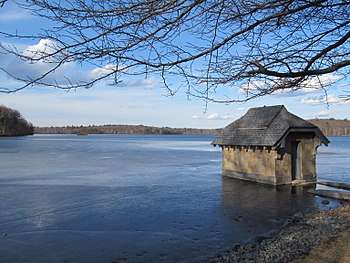Stony Brook (Charles River tributary, Weston)
Stony Brook is a stream largely running through Lincoln and Weston, Massachusetts, then forming the Weston/Waltham boundary, and emptying into the Charles River across from the Waltham/Newton boundary. It has two tributaries, Cherry Brook and Hobbs Brook, and its watershed includes about half of Lincoln and Weston as well as parts of Lexington and Waltham. Since 1887, it has been the water supply for Cambridge.

Various water mills have been erected at the mouth of Stony Brook: a corn mill in 1679-80; a paper mill in about 1802.[1]
In the late 19th century, Eben Norton Horsford identified the mouth of Stony Brook as the location of a supposed Norse city, Norumbega,[2] and commissioned the Norumbega Tower, which carries a long inscription describing the supposed city.
There are three large ponds, all artificial, in the Stony Brook watershed: the Cambridge Reservoir (Hobbs Pond), the Stony Brook Reservoir (Turtle Pond), and Flint's Pond (also known as Sandy Pond).
In 1887, on the site of Turtle Pond, the city of Cambridge completed construction of the Stony Brook Reservoir Dam, where Stony Brook joins the Charles, as part of its water supply.[3] Stony Brook Reservoir has a drainage area of 23.57 square miles (61.0 km2) and an available storage capacity of 354,000,000 US gallons (1,340,000 m3) (1087 acre-feet). In 1910, Hobbs Pond was dammed to become the Cambridge Reservoir.[4] Its drainage area is 7.25 square miles (18.8 km2) and its storage capacity is 2,338,000,000 US gallons (8,850,000 m3) (7178 acre-feet).[5] Flint's Pond (also known as Sandy Pond) was dammed to become the reservoir for the town of Lincoln; the DeCordova Museum is on its southeast bank.
External links
See also
- Hobbs Brook Basin Gate House
- Stony Brook (Merrimack River)
References
- Percival R. Eaton, "The Works of the Watch City", New England Magazine 36:3:365-66 (May 1906)
- Eben Norton Horsford, The discovery of the ancient city of Norumbega, 1890 full text
- "Stony Brook Reservoir". findlakes.com. Retrieved 11 April 2018.
- "Cambridge Reservoir". findlakes.com. Retrieved 11 April 2018.
- Division of Sanitary Engineering, "Advice to Cities, Towns and Others relative to Water supply, Drainage and Sewerage", in State Department of Health of Massachusetts, "Second Annual Report", Public Document No. 34 (1917) p. 384